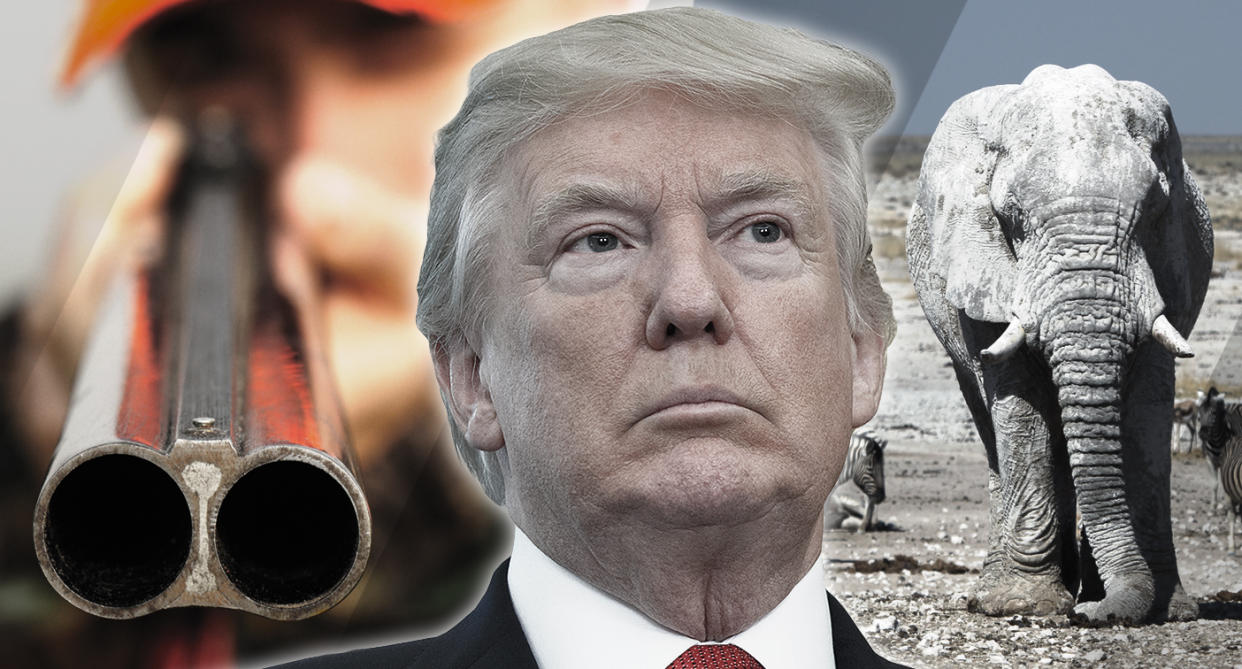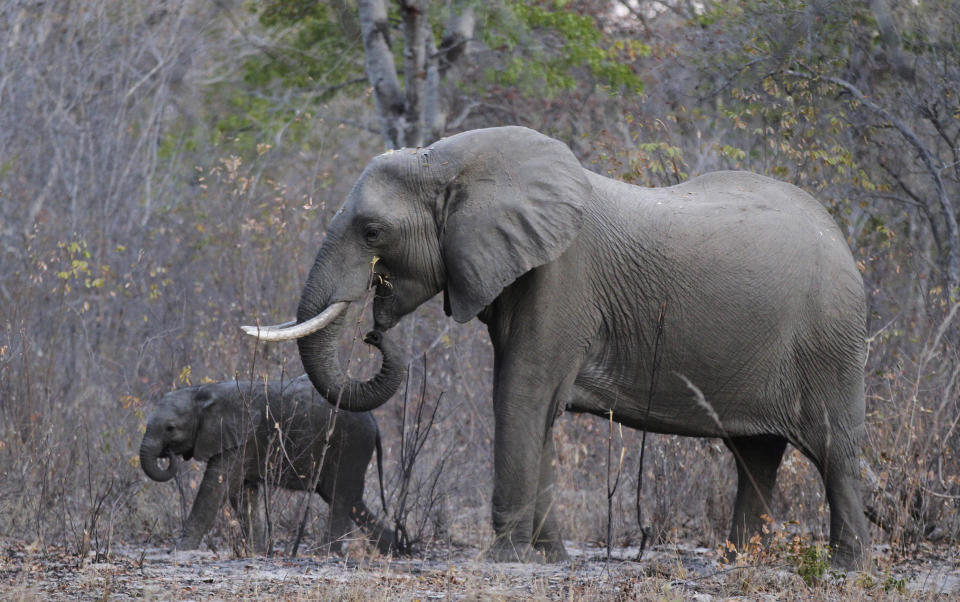The stuffed elephant in the room: Trophies, hunters and Donald Trump

If you are shooting at an elephant, aim for his ear. I learned this from a book titled “Hunter,” a memoir by a professional African hunter of the early 1900s, fortuitously named John A. Hunter. Shouldering a double-barreled .475-caliber Jeffery rifle that delivered a recoil like a thrown brick, he would clear the bush of lions that had developed an unfortunate taste for farmers, or arrange lavish big-game safaris for European aristocrats and rich Americans. “An elephant,” he wrote, “is so huge that there are only a few places on him where even the heaviest rifle bullet will bring instant death. The old-time ivory hunters like to aim for the ear orifice, or just ahead of it.”
Growing up in Brooklyn, I tucked that information away for future use, an occasion that never arose. I went my whole life without ever seeing an elephant shot to death, until this past week, when I came across a trove of elephant-killing videos, some posted by hunters themselves, others by outfits that run safaris. Hunter was right: a 1-ounce bullet into an elephant’s brain by way of the ear orifice instantly sends the six-ton animal crashing to the ground. Now that I have seen it, I wish to erase the sight from my memory, joining President Trump in revulsion at what he called, in a tweet last week, “this horror show” of elephant hunting.
Trump was provoked by a notice from the Department of the Interior stating that it would allow American hunters to bring elephant trophies home from two East African countries, reversing a ban imposed by the Obama administration. A trophy can be almost any part of the animal you don’t eat. Foremost are the ivory tusks; shooting an elephant is virtually the only legal way to bring ivory into the United States. All other ivory imports are banned to discourage poaching. A retired official in the Interior Department described to me some of the other things you can do with a dead elephant, including fashioning wastebaskets or umbrella stands from the feet, tanning the skin to make leather, or stretching and framing and printing a map of Africa on an ear, which viewed from a certain angle resembles the shape of the continent. Who wouldn’t want one of those for the living room?
Or in a prodigious feat of taxidermy, one can stuff and mount the entire carcass. “Some of these guys have trophy rooms that will knock your eyes out,” he mused. “I’ve seen one with the front half of an elephant mounted so it looks like it’s charging though the wall.” Not to everyone’s taste, but people spending $50,000 to kill an elephant want their money’s worth.

It evidently isn’t to Donald Trump’s taste, either, because when informed about the rule change he said he would ask Interior Secretary Ryan Zinke to put it on hold while he, Trump, “review[s] all conservation facts.” Trump’s aversion to hunting, a favorite activity of his two oldest sons, is one of the counterintuitive aspects of his personality. Trump is a self-proclaimed tough guy, a fan of cops, soldiers and almost anyone else who carries a gun. A lover of steak and meatloaf, he seems not to care much about animals while they are alive. He is the first president since before the Civil War without a pet at the White House. When Ringling Brothers Circus bowed to public opinion and announced it would stop using elephants in its shows, Trump was dismissive, tweeting “I, for one, will never go again. They probably used the animal rights stuff to reduce costs.” His appreciation for the natural world consists mostly in driving over it in a golf cart.
But something about shooting at large animals doesn’t sit well with Trump, who is known for having strong, if unpredictable, reactions to emotional images on cable news. Lifting the trophy ban was hailed by the National Rifle Association and the rich guys’ hunting lobby Safari Club International, but it was broadly unpopular on social media and even with some of Trump’s most ardent supporters in the media. It will be interesting to see where he comes down on the question, because his pledge to “review all conservation facts” will thrust him into a contentious and long-standing scientific debate.

The Interior Department action would affect trophy imports (by Americans, who constitute the great majority of hunters) from Zambia and Zimbabwe, two of the 18 countries with countable populations of African savanna elephants. It would put those in the same situation as South Africa and Namibia, countries where trophy imports are currently allowed. The long-term prospects for African elephants in the wild are dire, but they are not in imminent danger of extinction. A three-year effort to count them from the air ending in 2016 found 352,271 of them, a decline of 144,000 in less than a decade. But the biggest threats by far are poaching and habitat loss. Under quotas set by the international consortium known as CITES, legal trophy hunting accounts for only about 1,000 elephants a year. Even allowing for their two-year gestation period, elephant populations could easily stay ahead of that curve.
The question for the Interior Department was whether the two countries are managing their elephant herds sustainably. Krishna Roy, a consultant on environmental policy and a former official at the Fish and Wildlife Service, said she assumed at first the rule change was a political sop to hunters, but her former colleagues told her the science behind it is sound. Conservation groups mostly disagree. A coup in Zimbabwe recently ended the 30-year-long presidency of Robert Mugabe, and no one knows how the new government will treat its elephants. Many experts are skeptical of the claim that trophy hunting actually benefits elephants by generating revenue for conservation. “It’s good for the animals?” says Jeff Flocken, North American regional director of the International Fund for Animal Welfare. “It’s not good for the ones that are killed. We’re allowing rich Americans to hunt for sport at the same time we’re telling African people not to kill elephants for their ivory.” He adds that trophy hunting, like poaching, exerts a reverse Darwinian effect, by removing the fittest specimens — the ones with the biggest tusks — from the gene pool. Where poachers are at work, more and more elephants are being born without tusks altogether. Tuskless elephants are less likely to be shot, but they are bad for the species’ long-term survival. Scientists point out that, like every other part of an elephant, tusks evolved for a purpose.

Of course, Trump likes to boast of his disdain for “so-called scientists.” On hard decisions, his credo is to “go with your gut.” But unlike some other problems he faces, such as North Korean aggression, that’s a perfectly valid way to approach this one. In deciding whether to take a moral stand against killing a highly intelligent, social animal known to mourn its dead, you should consult your conscience, not a zoologist. Elephants are among a handful of species, humans among them, that exhibit self-awareness by recognizing themselves in a mirror. To kill one for pleasure is a profoundly immoral use of humanity’s technological prowess. To decorate one’s home with bits of its carcass is an unspeakable crime against esthetics. I never thought I’d say this, but on this one, Mr. President, go with your gut.
Read more from Yahoo News:




